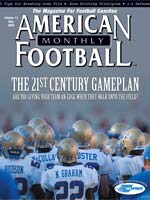AMERICAN FOOTBALL MONTHLY THE #1 RESOURCE FOR FOOTBALL COACHES
Article CategoriesAFM Magazine
|
Sterling College\'s - Principles of the 3-4 DefenseDefensive Coordinator, Sterling College© More from this issue Every coaching staff in America has to have a starting point when they put together an offensive or defensive scheme. Our defense staff at Sterling College is committed to four main principles. First of all, we are committed to having our best eleven football players on the field. Secondly, we want to position players where they will be able to make plays by being deceptive. Thirdly, we want to be assignment proof. And, finally, we want to minimize the ability of the offense to make big plays and their potential by involving eight players to stop the run game with the ability to play zone behind it. The 3-4 defense allows us to get our best eleven players on the field at the same time. As with many small colleges today, we have a hard time recruiting the 6’2”, 265....The full article can only be seen by subscribers. Subscribe today!
|
|
|||||||
| HOME |
MAGAZINE |
SUBSCRIBE | ONLINE COLUMNISTS | COACHING VIDEOS |
Copyright 2025, AmericanFootballMonthly.com
All Rights Reserved





